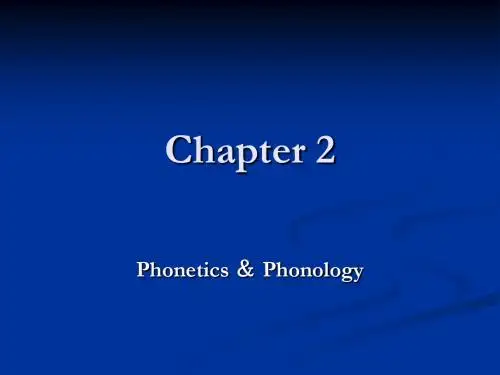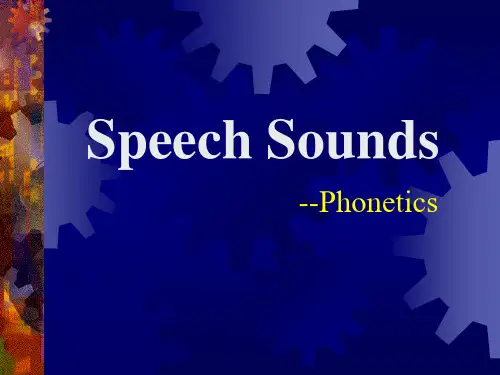语言学教程课件2 Phonetics and Phonology
- 格式:ppt
- 大小:2.52 MB
- 文档页数:105
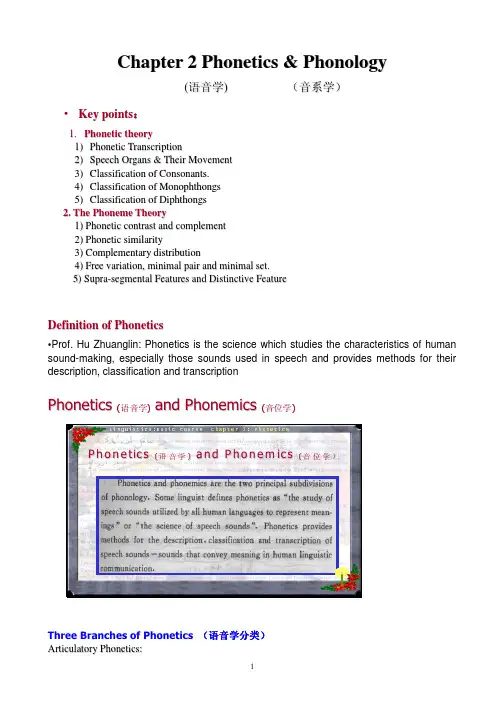
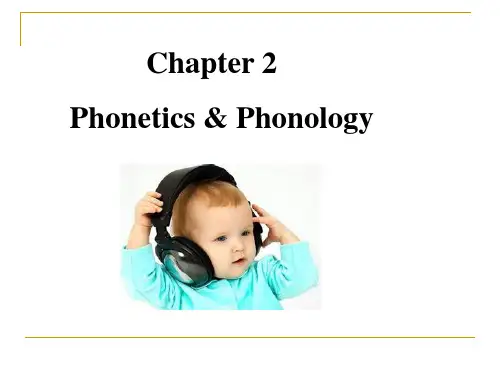
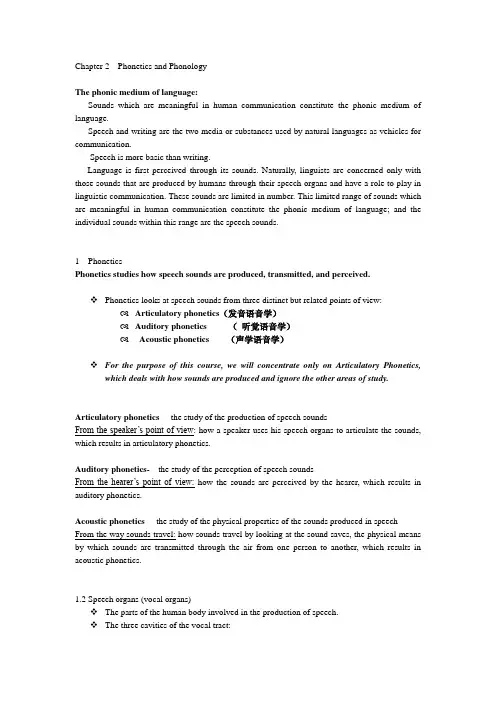
Chapter 2 Phonetics and PhonologyThe phonic medium of language:Sounds which are meaningful in human communication constitute the phonic medium of language.Speech and writing are the two media or substances used by natural languages as vehicles for communication.Speech is more basic than writing.Language is first perceived through its sounds. Naturally, linguists are concerned only with those sounds that are produced by humans through their speech organs and have a role to play in linguistic communication. These sounds are limited in number. This limited range of sounds which are meaningful in human communication constitute the phonic medium of language; and the individual sounds within this range are the speech sounds.1 PhoneticsPhonetics studies how speech sounds are produced, transmitted, and perceived.Phonetics looks at speech sounds from three distinct but related points of view: Articulatory phonetics(发音语音学)Auditory phonetics (听觉语音学)Acoustic phonetics (声学语音学)For the purpose of this course, we will concentrate only on Articulatory Phonetics, which deals with how sounds are produced and ignore the other areas of study.Articulatory phonetics----the study of the production of speech soundsFrom the speaker’s point of view: how a speaker uses his speech organs to articulate the sounds, which results in articulatory phonetics.Auditory phonetics----the study of the perception of speech soundsFrom the hearer’s point of view:how the sounds are perceived by the hearer, which results in auditory phonetics.Acoustic phonetics----the study of the physical properties of the sounds produced in speech From the way sounds travel: how sounds travel by looking at the sound saves, the physical means by which sounds are transmitted through the air from one person to another, which results in acoustic phonetics.1.2 Speech organs (vocal organs)The parts of the human body involved in the production of speech.The three cavities of the vocal tract:the pharyn / throat (pharyngeal cavity) 咽腔,the mouth (oral cavity) 口腔,the nose (nasal cavity) 鼻腔.The air- stream coming from the lungs is modified in various ways in these cavities, resulting in the production of various sounds.发音器官的构造及其作用世界上所有的声音都是物体振动产生的声波在介质中传递的结果,因此声音的产生离不开振动的动力、振动的源头和振动的共鸣腔。
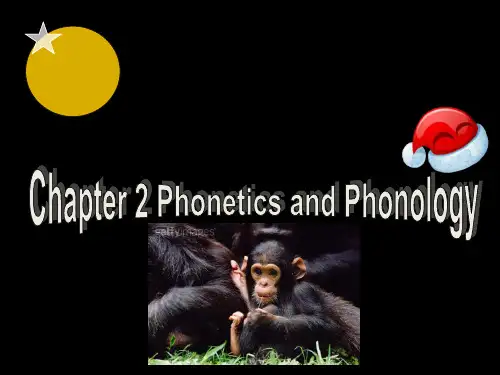
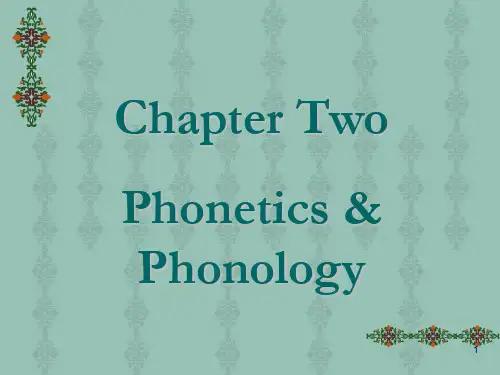
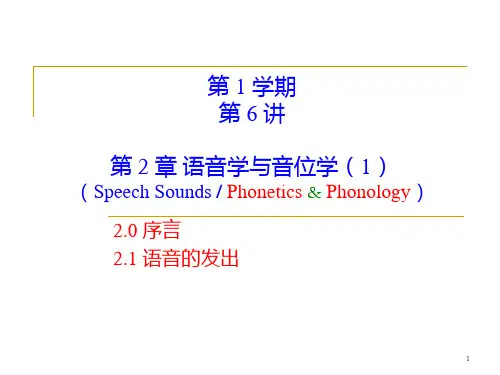
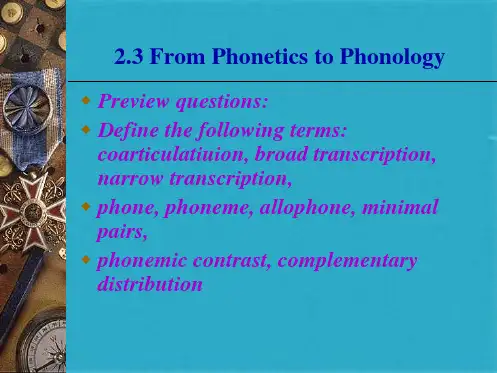
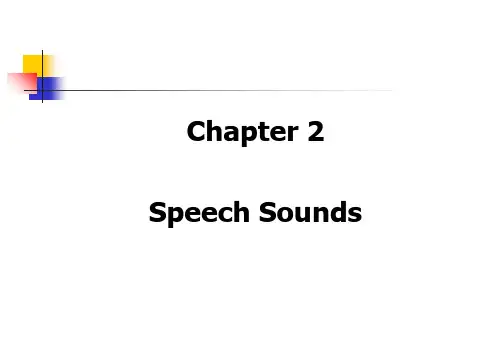
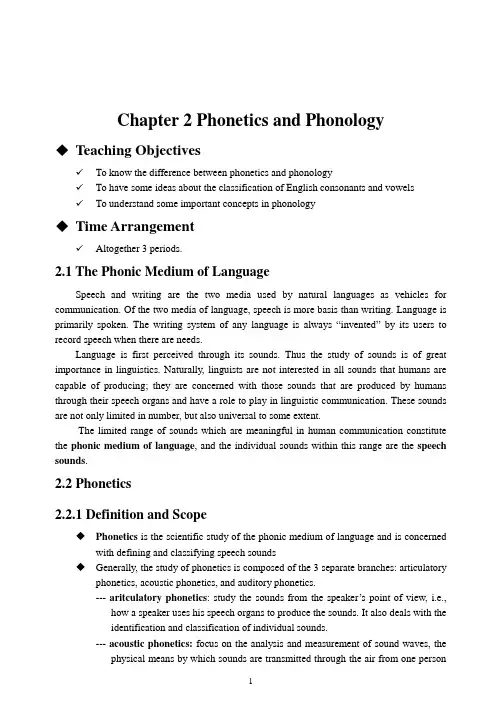
Chapter 2 Phonetics and Phonology◆Teaching Objectives✓To know the difference between phonetics and phonology✓To have some ideas about the classification of English consonants and vowels✓To understand some important concepts in phonology◆Time Arrangement✓Altogether 3 periods.2.1 The Phonic Medium of LanguageSpeech and writing are the two media used by natural languages as vehicles for communication. Of the two media of language, speech is more basis than writing. Language is primarily spoken. The writing system of any language is always “invented”by its users to record speech when there are needs.Language is first perceived through its sounds. Thus the study of sounds is of great importance in linguistics. Naturally, linguists are not interested in all sounds that humans are capable of producing; they are concerned with those sounds that are produced by humans through their speech organs and have a role to play in linguistic communication. These sounds are not only limited in number, but also universal to some extent.The limited range of sounds which are meaningful in human communication constitute the phonic medium of language, and the individual sounds within this range are the speech sounds.2.2 Phonetics2.2.1 Definition and Scope◆Phonetics is the scientific study of the phonic medium of language and is concernedwith defining and classifying speech sounds◆Generally, the study of phonetics is composed of the 3 separate branches: articulatoryphonetics, acoustic phonetics, and auditory phonetics.--- aritculatory phonetics: study the sounds from the speaker’s point of view, i.e., how a speaker uses his speech organs to produce the sounds. It also deals with theidentification and classification of individual sounds.--- acoustic phonetics: focus on the analysis and measurement of sound waves, the physical means by which sounds are transmitted through the air from one personto another.--- auditory phonetics: study the sounds from the hearer’s point of view, i.e., how the sounds are perceived (感知) by the hearer.◆The 3 branches are closely related to each other. Speech sounds cannot be divorcedfrom the organs that articulate them and a sound wave does not exist in isolation from the source that generates it. All the approaches are indispensable to an understanding of phonetics.◆In this part we’ll focus on articulatory phonetics and at the same time make somereference to the acoustic properties of sounds when necessary.2.2.2 Vocal Organs / Articulatory Apparatus (p.16)The articulatory apparatus of a human being are contained in 3 important areas: the pharyngeal cavity – the throat, the oral cavity – the mouth, and the nasal cavity – the nose.The air stream coming from the lungs may be modified in the larynx, and in these cavities in various ways. Such modification results from kind of interference with the movement of the air stream.➢The pharyngeal cavity--- when vocal cords are relaxed and folded back at each side to let air flow through freely and silently without causing vibration, the sounds produced in such acondition are voiceless.--- when vocal cords are held together tightly so that the air stream vibrates them at different speeds while forcing its passage through them, the vibration of the vocalcords results in a quality of speech sounds called voicing, which is a feature of allvowels and some consonants in English.➢The oral cavity--- the greatest source of modification of the air stream is found here.--- of all the speech organs in this cavity, the tongue is the most flexible and is responsible for more varieties of articulation. [k] [g] [j] [t] [d] [] [] --- apart from the tongue and the roof of the mouth, obstruction can be created between the upper teeth and the lower lip and between the lips [f] [v] [p] [b] ➢The nasal cavity--- when the passage of air to the mouth is closed so that air is allowed to exit through the nose, the sounds pronounce are nasalized. [m] [n] []2.2.3 Transcription of Sounds (p.17)✓With the need for a standardized and internationally accepted system of phonetic transcription, the International Phonetic Alphabet (IPA)came into being in 1888,whose basic principle is using one letter selected from major European languages to represent speech in the form of segments, or individual speech sounds.✓As some speech sounds produced differ only in some detailed aspects, the IPA provides its users with another set of symbols called diacritics, which are added to the letter-symbols to bring out the finer distinctions than the letters alone may possibly do.✓Thus there are two ways to transcribe speech sounds: broad transcription-- the transcription with letter-symbols only and narrow transcription -- the transcription with letter-symbols together with the diacritics.✓Broad transcription is the transcription normally used in dictionaries and teaching textbooks for general purposes. Narrow transcription is the transcription needed and used by the phoneticians in their study of speech sounds.✓Example 1:[l] in the four words leaf [li:f], feel [fi:l], build [bild], health [hel] and play [plei] –differ [l] in [li:f], occurring before a vowel, --- a clear [l]清晰音, no diacritic is needed[l] in [fi:l] and [bild], occurring at the end of a word or before another consonant, --- a dark [l]模糊音--- in narrow transcription the diacritic [~] is used [l] in [hel], followed by the dental sound and affected by it, --- a dental [l] --- in narrow transcription the diacritic is used[l] in [plei], following a voiceless plosive (p), -- a devoiced [l] 清音化--- in narrow transcription the diacritic [0] is used.✓Example 2:[p] in [pit] and [spit][p] in [pit], pronounced with a strong puff of air --- aspirated [p] --- [p h it][p] in [spit], pronounced with a withheld puff of air--- unaspirated [p] --- [spit]✓Example 3:play broad [plei] narrow [ ] aspiration, devoicingtenth broad [ten] narrow [ ] aspiration, nasalization, dentalization 2.2.4 Classification of English sounds2.2.4.1 English Consonants (24 / 28) p.18An initial classification will divide the speech sounds into two broad categories: vowels and consonants,In the pronunciation of consonants the air that comes from the lungs meets with obstruction in one way or another.Traditional linguists think there are altogether 28 consonants. But modern linguistics believe that there are 24 consonants, not including /tr/, /dr/, /ts/, /dz/because they are notconsidered as independent sounds, but the consonant clusters.Consonants are usually classified according to their place of articulation and manner of articulation.--- in terms of manner of articulation:6 stops / plosives; 9 fricatives; 2 affricates; 2 liquids (a lateral & a retroflex)3 nasals; 2 glides / semivowels; (trills in some regional accents)--- in terms of place of articulation:4 bilabials; 2 labiodentals; 2 dental sounds; 7 alveolar sounds;5 palatal sounds; 3 velar sounds; 1 glottal2.2.4.2 English Vowels (20/25) p.20As in the production of vowels the air stream meets with no obstruction, they cannot be classified in terms of manner of articulation or place of articulation as consonants. Other criteria have to be found for their classification.1) Openness of the mouth (close, semi-close, semi-open, open)2) Position of the highest part of the tongue (front, central, back)3) Degree of lip rounding/shape of lips (rounded, unrounded)4) Length of the vowel (long, short)5) Pure or gliding (monophthong, diphthong, triphthong)Diphthongs – A vowel sound that glides from one quality to another: 8Triphthongs -- a vowel sound that glides successively through three qualities: 52.3 Phonology2.3.1 Phonology and PhoneticsSimilarity: research objects ---- the speech soundsDifference: research approaches and focusesPhonetics – general study of all the speech sounds used in all human languages about how they are produced, how they differ from each other, what phoneticfeatures they possess, how they can be classified, etc.Phonology – about how speech sounds in a language form patterns and how they areused to convey meaning in linguistic communication.2.3.2 Phone, Phoneme, and allophone◆Phone and phonemeA phone is A phoneme isA phonetic unit, concrete A phonological unit, abstractOne of many possible sounds Not any particular sound, but represented or heard or produced in languages realized as a certain phoneThe smallest identifiable unit The smallest contrastive unit distinguishing found in a stream of speech, not between meanings of words in the sound necessarily distinguish meaning system of a particular language.Pronounced in a defined way. Pronounced in one or more ways,depending on the number of allophones.Represented between brackets Represented between slashesby convention. E.g. [b], [j], [o] by convention. E.g. /b/, /j/, /o/◆Allophones--- different phones that can represent a phoneme in different phonetic environment.--- variants of a phoneme which do not change the meaning with substitution--- For example, /p/ → [p h i: k] & [spi:k]/t/ → [t h i: k] & [sti:k]/l/ → [li:k] & [fi:l] & [hel] & [milk]--- Distinctive features (p.24):the features that a phoneme possesses, making it different from other phonemes;shown in the form of a binary opposition, only one of two values [+] or [-];e.g.: /p/ → -syllabic +consonantal –sonorant +anterior –coronal -voiced –nasal构成音节的响音前面的舌尖音的/i:/ → +syllabic –consonantal +sonorant +high – back –round +continuant响音:all vowels + consonants /l/, /m/, /n/, / /, /r/, /w/, /j/2.3.3 Phonemic contrast, complementary distribution and minimalpair (p.24)➢Phonemic contrast--- formed by two distinctive phonemes➢Complementary distribution--- Allophones of the same phoneme do not distinguish meaning, but complement each other in distribution. That is, they occur in different phonetic environmentsand they are said to be in complementary distribution.➢Minimal pair--- a basic way to determine the phonemes of a language is to see if substituting one sound for another results in a change of meaning. If it does, the two soundsthen represent different phonemes.--- an easy way to do this is to find the minimal pairs:2 different forms are identical in every way except for one sound segment whichoccurs in the same place in the strings → the 2 sound combinations forming aminimal pair → the 2 sounds representing different phonemes.more than 2 sound combinations → constituting a minimal set together.--- This way applies both to the consonants and vowels--- E.g.: pill & bill, bill & kill, kill & till, till & pill → minimal pairspill, bill, kill, till →a minimal set (identical in form except for the initialconsonant) → /p/, /b/, /k/, /t/ phonemesbeat, bet, boot, but, bait, bite, boat → a minimal set (identical except for thevowel) →/i:/, /e/, /u:/, //\/, /ei/, /ai/,/eu/ phonemes2.3.4 Phonological rules (p.25)2.3.4.1 Sequential rulesThe phonemes of a language cannot not strung together in any random order to formwords. The phonological system determines which phonemes can begin a word, end a word, and follow each other.e.g.: /b/ , /l/, /i/, /k/ p.25If a word begins with a [l] or a [r], the next sound must be a vowel.If three consonants should cluster together at the beginning of a word, the combination should obey the following 3 rules;(1)The first phoneme must be /s/(2)The second phoneme must be /p/ or /t/ or /k/(3)The third phoneme must be /l/ or /r/ or /w/e.g.: spring /spri/, strict /strict/, square/skew/, splendid /splendid/, scream /skri:m/Every word must contain at least one vowel-like segment.The rules governing the phonological patterning are language specific. What is not permissible in English might be permissible in another language.2.3.4.2 Assimilation rule⏹When we speak, we tend to increase the ease of articulation. This “sloppy” tendencymay become regularized as rules of language. The assimilation rule assimilates onesound to another by “copying” a feature of a sequential phoneme, thus making thetwo phones similar.Nasalization of vowels in certain phonetic contexts.e.g.: [i:] – bean, green, team, screamThe varying pronunciation of the alveolar nasal /n/ in some sound combinatione.g.: alveolar nasal /n/ -- still alveolar nasal in indiscreet (for /d/ is an alveolar stop)alveolar nasal /n/ -- velar nasal // in incorrect ( for /k/ is a velar stop) The sound assimilation is actually reflected in the spelling in most cases.Inpossible → impossible, as the /n/ sound is assimilated to /m/Inplausibel → implausible, inlegal → illegal, inregular --. irregular2.3.4.3 Deletion rule⏹It tells when a sound is to be deleted although it is orthographically represented.e.g.: sign, design, paradigm → no /g/ sound though it is represented in spelling bythe letter gsignature, designation, paradigmatic →/g/ represented by the letter g ispronouncedThe rule is: delete a /g/ when it occurs before a final nasal consonant.2.3.5 Suprasegmental FeaturesSegment -- any linguistic unit in a sequence which may be isolated from the rest of the sequence, e.g. a sound in an utterance or a letter in a written textSuprasegmental – (in phonetics and phonology) a unit which extends over more than one sound in an utterance., e.g. syllable, word, sentence.2.3.5.1 StressStress is the pronunciation of a word or syllable with more force than thesurrounding words or syllables. Briefly, stress is syllable prominence.Stress in a syllable is achieved by changing the pitch, making the syllablelouder, or making it longer.In a word, the basic difference is between stressed and unstressed syllables.The syllable with the greatest prominence had the primary stress and the nextstressed syllable the secondary stress. A word, if long enough, may haveseveral nonprimary stresses. However, no word has more than one primarystress.Stress has two main semantic functions: distinguishing between two words which are alike, e.g. \import (n.) and im\port (v.); emphasizing the syllable or word,e.g. I said induce, not deduce.There are two kinds of stress: word stress and sentence stress.Word stress – the location of stress distinguishes meaning.(1) a shift of stress may change the part of speech of a word form a noun to averb.e.g.: \increase (n.) – in\crease (v.); insult (n.) – insult (v.); rebel (n.) – rebel (v.)(2) the alteration of stress occurs between a compound noun and a phraseconsisting of the same elementse.g.: \blackbird (compound) – a particular kind of bird, which is notnecessarily black.black \bird (noun phrase) – a bird whose color is blackgreenhouse – green house; hotdog – hot dog(3) the meaning-distinctive role played by word stress is also manifested in the–ing + noun combinations.e.g.: \dining room (compound) -- -ing serving as a modifier of the nounreading glasses, sewing machinesleeping \baby (noun phrase) – noun as the doer of the action indicatedby the –ing form , which is an –ing participle modifierswimming fishSentence stress(1)the parts of speech that are normally stressed in English are nouns, mainverbs, adjectives, adverbs, numerals and demonstrative pronouns.(2)The other categories of words like articles, person pronouns, auxiliary verbs,prepositions and conjunctions are usually not stressed.(3)To give special emphasis to a certain notion, a word in a sentence that isusually unstressed can be stressed.e.g.: He is driving my car.2.3.5.2 ToneTone is pitch variations which are associated with the pronunciation of syllables orwords and which affects the meaning of the word.A tone language is a language in which the meaning of word depends on the toneused when pronouncing it.Mandarin Chinese, a typical ton language, makes a distinction between fourdifferent tones.Other tone languages are spoken in Vietnam, Thailand, West Africa, and CentralAmerica.2.3.5.3 IntonationWhen speaking, people usually raise and lower the pitch of their voice, formingpitch patterns. They also give some syllables in their utterances a greater degree ofloudness and change their speech rhythm. These phenomena are called intonation.In other words, when pitch, stress and sound length are tied to the sentence ratherthan the word in isolation, they are collectively known as intonation.English has four basic types of intonation, known as the four tones – the falling tone,the rising tone, the fall-rise tone, and the rise-fall tone.。
